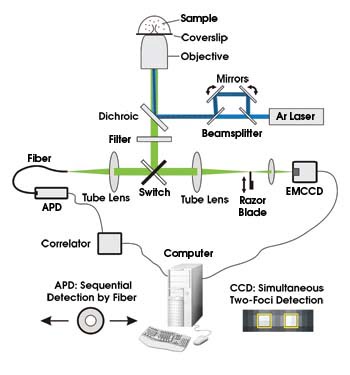
Making Fluorescence Correlation Spectroscopy Flexible
Gary Boas
Fluorescence correlation spectroscopy helps to shed light on the behavior of molecules in aqueous solutions by measuring fluctuations in fluorescence intensity. Typically, data is collected from a single, fixed-focus position within the sample. However, many applications — monitoring of large-scale translocation and spatial dynamics, for instance — require multiple excitation and detection schemes.

Scientists have evaluated electron multiplying CCD (EMCCD) cameras for detection in fluorescence correlation spectroscopy, comparing their performance with that of conventional avalanche photodiodes (APDs). Such detection could contribute to applications including simultaneous intracellular measurements at various positions. Reprinted from Optics Express with permission.
Researchers have developed fixed multispot excitation and detection systems for fluorescence correlation spectroscopy, but to date no flexible multispot strategies have been introduced. In the June 12 issue of Optics Express, investigators Markus Burkhardt and Petra Schwille of Dresden University of Technology in Germany compared the performance of the avalanche photodiodes conventionally used for detection in the technique with that of electron multiplying CCD cameras, which are often used for parallel detection for scanning laser microscopy applications. The latter have been available commercially for several years and, because of their high sensitivity and speed, should be applicable for fluorescence correlation spectroscopy measurements.
A number of applications could benefit from such flexible, parallel multispot detection, Burkhardt said, including simultaneous intracellular measurements at various positions and spatial cross-correlation between positions — to detect transport or flow properties, for example. He added that the electron multiplying CCD camera could be used for spectrally resolved fluorescence correlation spectroscopy, “where individual channels can be chosen by the appropriate number of CCD pixels to which the emission spectrum is dispersed.”
The investigators used a setup based on an inverted microscope made by Olympus of Hamburg, Germany, with a 60× water immersion objective. A 488-nm laser made by Spectra-Physics of Darmstadt, Germany, provided the excitation light, which was split and rejoined by beamsplitters made by Thorlabs Europe of Karlsfeld, Germany, enabling two separate excitation volumes. A switch for the left or right side port of the microscope determined which detection method was used. “Left” sent the collected fluorescence to an avalanche photodiode detector; “right,” to an electron multiplying CCD camera made by Andor Technology of Belfast, UK.
The proof-of-principle experiments revealed good agreement between the two methods and showed that a time resolution of 20 μs was possible with the CCD camera — high enough to follow freely diffusing molecules in solution. Though avalanche photodiode detection also allows parallel measurement (in this case, with a dual core fiber and two photodiodes), use of electron multiplying CCD cameras enables varying distances between the two separate volumes and could be extended to detect fluorescence from three or more volumes at the same speed.
Use of electron multiplying CCD cameras for fluorescence correlation spectroscopy is currently limited by detection speed: The time resolution in the preferred continuous readout mode corresponds to the sequential readout of the CCD chip. The detection speed should improve, however, as the readout speed of the CCD cameras increases.
Published: September 2006